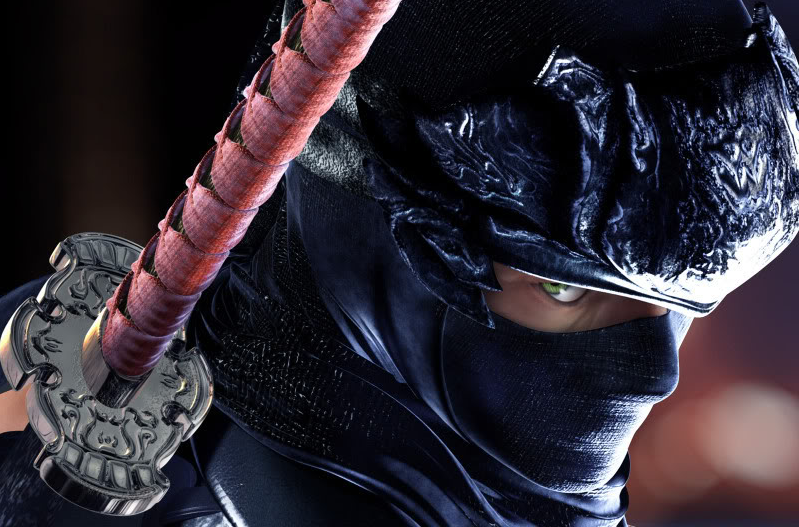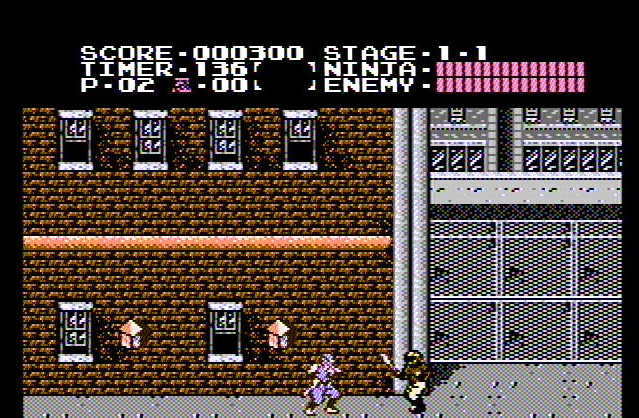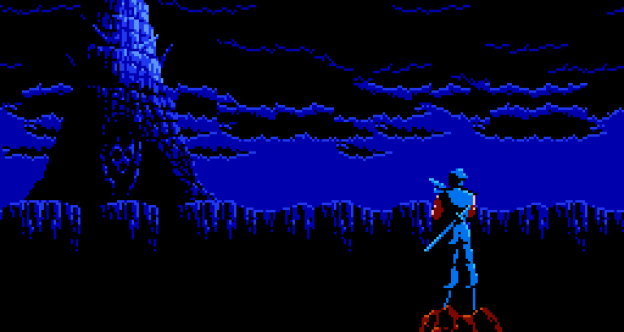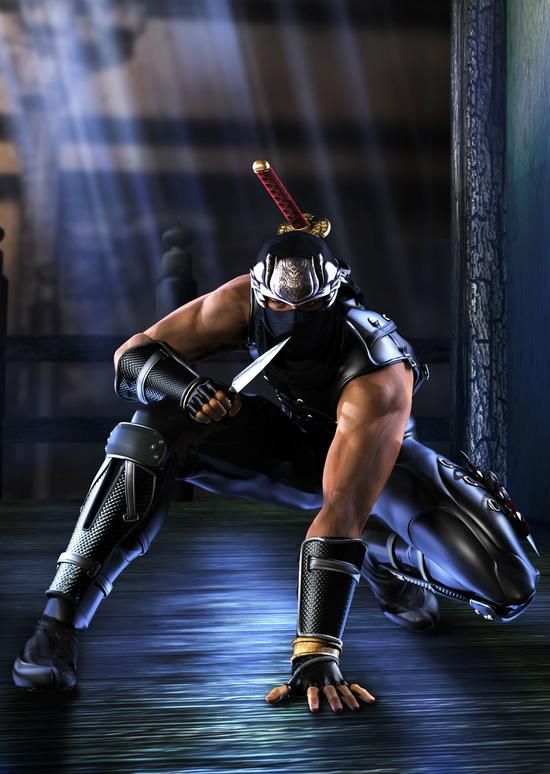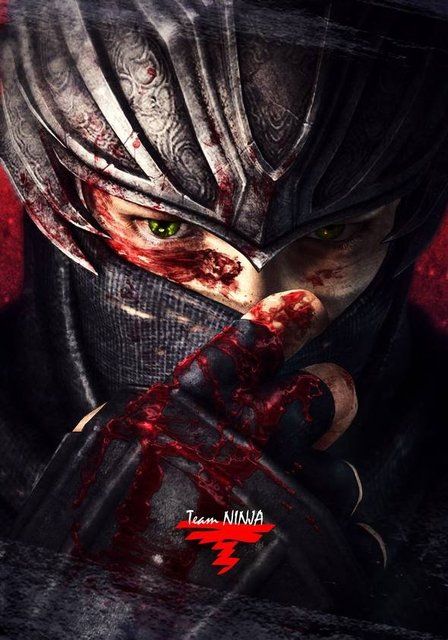Mention the name Ninja Gaiden to any action game fan and you’re bound to yield a delighted smile. Since the first installment hit arcades more than twenty-one years ago, the series has become synonymous with the term 'ninja game' and known the world over for its unforgiving difficulty and enemy AI. With the series reboot Ninja Gaiden 3 set to hit home consoles in just a few more days, there's never been a better time to reflect on the series' history, which is much longer and storied than most people know. Welcome to another very special installment of Then and Now.
Ninja Gaiden: Enter Ryu Hayabusa, Master Ninja
The original Ninja Gaiden was released to arcades in North America in 1988. A far cry from the newer, 3D NG games, the original Ninja Gaiden was a 2D side-scrolling beat'em up in the spirit of Streets of Rage or Double Dragon. It would become the first and only series installment to see release within an arcade. The remainder of the games in this era would be released for the Nintendo Entertainment System. This version of the first game did little to differ from its contemporaries, but most of the material present was scrapped for the console version of Ninja Gaiden which is considered by most to be the ‘official’ first game in the series. The arcade and console versions of Ninja Gaiden were developed by different teams.
In 1989 Ninja Gaiden debuted on the NES in North America. This would become the official first game in the eventual NES trilogy of NG games. Compared to the arcade game, this NG featured a much greater emphasis on platforming, story, narrative, difficulty, sound and visuals. The story focused on master ninja Ryu Hayabusa and his epic journey for revenge. Unlike later games, the story in NG showed a softer side of Ryu. While he has rescued female characters a few times throughout the series' history, he's never had a love interest as prominent as Irene Lew. There is even a kissing scene at the end.
This game also featured advanced graphics compared to the arcade version. For the time the title was technically impressive, pushing the NES to its technical limits. Future series installments would similarly challenge their respective platforms. The game released in 1989 to fantastic reception. Reviewers praised many aspects of the game, most notably its visuals and game-play. The use of cutscenes and cinematics in the game was called “groundbreaking”. The fast combat and detailed environments were cited as high points as well. Reviewers gushed over the satisfying challenge and depth of story. NG was quickly crowned as one of the best executed games of its kind and it remains a standout of the NES’s vast library. A classic was born.
Though no official sales numbers for this game are readily available, it was a legitimate hit popular enough to spawn two immediate sequels and, of course, a reboot down the line. It has been cited as one of the most difficult 8-bit games ever (which is quite a lofty title, in case you didn't know) and to this day is perennially popular amongst NES purists and diehard challenge seekers alike. By and large, the game was the start of a strong franchise. It would later be ported to the PC and Game Boy and then eventually the mobile phone and Wii Virtual Console.
Ninja Gaiden II and III: If it Ain’t Broke…
Just fourteen months after the release of Ninja Gaiden, Ninja Gaiden II: The Dark Sword of Chaos was released for the NES. The game would become available for the PC the following year, in 1991. Like the first game, it was also released for the Wii Virtual Console in 2007. Rather than make any significant changes, the team focused on making the title technically superior to the first. The game continued the story of NG and featured more impressive graphics, cinematics, and environments.
There were also various new power-ups added, such as health upgrades and attack boosts. The nerve-bending difficulty and dynamic platforming made a comeback. Also, the game reused a few assets from the first NES NG. Reception of NGII was just as positive as for the first game. Reviewers praised the upgraded graphics and new abilities, as well as the furthered story and polished narrative. By improving on the formula used in the first game, NGII easily wowed gamers once again. After the second success, the development team quickly began work on a sequel to NGII.
Within thirteen months of the launch NGII, in 1991, Ninja Gaiden III: The Ancient Ship of Doom hit store shelves. Like the games before it, it launched exclusive to the NES but was later ported to various other platforms. NGIII would eventually be released for the short lived Atari Lynx handheld and, like its formers, the Virtual Console. This game featured a new story instead of furthering the one established in the last two games. After being accused of murdering his love interest Irene, Ryu must unravel a CIA conspiracy to discover her whereabouts. Of course a much bigger, more sinister plot is revealed over the course of the game.
The game-play in this installment remained largely the same as in the second game, with the addition of some new power-ups and platforming mechanics. Like both NG and NGII, NGIII was met with widespread positive critical reception. The formula was still exciting and the new moves and story were cited as improvements. The game effectively closed the NES trilogy, making way for Ninja Gaiden Trilogy, a compilation of all three numbered games for the Super Nintendo Entertainment System. This compilation was released in 1995.
There were also two NG games released for Sega’s Master System and Game Gear platforms, although these are quite different from the NES games. After the release of the NG Trilogy, the series faded from relevance for the first time since its console debut. Nothing was heard from the series for years and it was thought to have become another one of the many gaming franchises from that era that had simply withered away like Streets of Rage, Final Fight or Double Dragon. Of course, that was before Team Ninja and outspoken lead designer Tomonobu Itagaki got their hands on it.
Ninja Gaiden: Team Ninja, Tomonobu Itagaki, and the Best Ninja game Ever Made
Team Ninja originally began developing the title that would revive the Ninja Gaiden name for the Sega Dreamcast in 1999, just four years after the release of the NG Trilogy. The game wouldn’t see release for several more years, however. The Dreamcast was short lived, and after its failure the team decided that the PlayStation 2 was a suitable platform. This was until lead designer Tomonobu Itagaki was introduced to the Xbox. Itagaki is known for being very selective about the hardware that he utilizes to make ‘his’ games. He only likes to create games for the most powerful platform around. After becoming smitten with the technical capabilities of the Xbox, Itagaki convinced the team to create their game exclusively for the Xbox.
The game hit the console like a hurricane. The story focused on master ninja Ryu Hayabusa and his quest for vengeance. Sound familiar? Compared to the story in the NES NG games, this story starred a much less talkative, less passionate Ryu. He was less human, but also much more ninja. This time he’s avenging the death of Kureha, his clan’s shrine maiden. Don’t worry though; he never gets all lovey dovey this time around. He remains silent and mysterious like a ninja throughout.
The graphics were nothing short of stunning, with characters, enemies and environments demonstrating a remarkable level of detail and polish. Aggressive enemy AI made the game incredibly difficult, much to the delight of series fans, and the air tight controls put victory or demise in the hands of the player. The combat was fluid and beautiful and Ryu’s arsenal of weapons and techniques was vast. Ninja Gaiden challenged players to sharpen their reflexes and block, parry, counter and evade the waves of powerful attacks from enemies. The title also featured a heavy focus on violence, with tons of blood and grisly gore. This blatant sadistic action component has become a defining element of the series.
Ninja Gaiden also utilized the Xbox’s networking capabilities by implementing an online leaderboard. Furthermore, the game possessed a unique, refined level of difficulty that was and is rarely seen in the medium nowadays. It also packed in the Ninja Gaiden Trilogy as an unlockable, just to sweeten the pot. In 2004, Ninja Gaiden released to glowing reviews. The game was called a technical marvel, leagues beyond anything else available on the platform. The no hand-holding game-play and difficulty, as well as the unabashed focus on violence and the insane enemy AI were all praised. Because of the title’s depth of game-play, difficulty and technical excellence, Ninja Gaiden is recognized by many as the best ninja video game of all time.
It has received notable awards from various publications including Xbox Game of the Year from EGM and IGN for 2004 and 2005 respectively. The combined sales figures of the first Ninja Gaiden and its subsequent enhanced re-release Ninja Gaiden Black cleared 1.5 million units by 2007. Their backwards compatibility with the Xbox 360 has probably resulted in more sales since then. Ninja Gaiden Black is also the fourth best reviewed Xbox game ever on review aggregate Metacritic with a score of 94.
Ninja Gaiden 2: Following up the Best Ninja game Ever Made
Development on Ninja Gaiden 2 is believed to have begun immediately following the release of Ninja Gaiden Black in 2005. This is likely because Team Ninja had just finished work on their Xbox 360 debut Dead or Alive 4 around this time. The game was first revealed in 2007 and then released in 2008. The team focused on creating visuals and game-play that exhausted the strength of the Xbox 360. The main game-play components and formula would return from the first game, though refined. Itagaki intended for Ninja Gaiden 2 to utilize the Xbox 360 to its full power, just as the prequel utilized the Xbox. Expectations for the game were high after such a strong showing the first time around.
Impossibly, Ninja Gaiden 2 delivered. The graphics were unbelievably rich and detailed. It quickly gained a reputation as one of the console’s most beautiful games. The game-play was back and as irresistible as ever. Ryu came equipped with tons of new weapons and techniques. The new obliteration techniques added flashy, show-stopping attacks without slowing down the action. The gorgeous new ninpo lit the battlefield ablaze with visual flourishes and effects. New enemies were added and old favorites returned. Enemy AI was improved upon. Enemies now behaved more aggressively according to how close they are to death, using selfless kamikaze attacks to deal enormous damage when they’ve been dismembered.
The violence was kicked up yet another notch, with a new system allowing Ryu to brutally dismember and decapitate his foes. There was even more blood and gore. Enemies sprayed blood when decapitated and blood remained on surfaces for extensive amounts of time. Furthermore, severed limbs and heads also littered the environments after battles. Like the first game, NG2 also included an online component. This time players could upload their own game-play videos and download the videos of players from around the world using the Ninja Theatre. Very awesome feature, I should add.
The story continued Ryu’s tale, set one year after the events in the first game. You’re probably noticing a pattern by now. Team Ninja borrowed subtly from the NES games in various ways, something only longtime fans will notice. Ryu eventually embarks on a quest to beat back the vile Black Spider Clan and banish a group of powerful otherworld fiends.
As expected, Ninja Gaiden 2 released to critical and commercial success. Critics cooed over the amazing visuals and fantastic weapon variety and combat. The hardcore, sadistic action that won fans over with the first installment had returned bigger and better than ever. The unforgiving difficulty had returned and the new enemies and bosses proved as challenging as ever. Since 2008, Ninja Gaiden 2 has sold more than one million copies for the Xbox 360. It currently retains a score of 81 on Metacritic.
Ninja Gaiden Sigma and Itagaki's Departure
Itagaki revealed shortly before the release of Ninja Gaiden 2 that he would be parting ways with Tecmo after working with them for sixteen years. The nasty split saw Itagaki suing the company for unpaid bonuses. While the exact details of what caused Itagaki’s departure were unclear, gamers were more concerned with what would become of the game franchises that he lead to success; namely Ninja Gaiden.
The future seemed glum. Rather than immediately begin work on a new Ninja Gaiden game, the team began work on a port of NG2 for the PlayStation 3. The first game had been ported to PS3 in 2007 as Ninja Gaiden Sigma, with no direct input or direction from Itagaki even though he was still with Team Ninja. This reflects the negative situation between the designer and the company roughly one year from his official resignation. This is further elaborated by Itagaki’s openly stated criticisms of Ninja Gaiden Sigma.
Nevertheless, Ninja Gaiden Sigma 2 was released in 2009. Although the port lacked the sheer difficulty and gore of NG2, it added online multiplayer and multiple playable characters, as well as dozens of additional missions. PS3 owners jumped at the opportunity to play the lauded Ninja Gaiden games. Ninja Gaiden Sigma and Sigma 2 currently maintain Metacritic scores of 88 and 83 respectively. Sigma 2 carries a higher score than its Xbox 360 counterpart. Ninja Gaiden Sigma would later be ported to the PlayStation Vita as Ninja Gaiden Sigma Plus. After remaining Xbox exclusive for so long, the games were bound to hit the PS3 with significant momentum.
After the release of Ninja Gaiden Sigma 2, not much else was heard from Team Ninja or the series. It had seemed that the loss of Itagaki was too significant of a blow for the famed series to recover from.
Ninja Gaiden 3: To Ninja Infinity...and Beyond!
This was until the 2010 Tokyo Game Show when the developer reintroduced itself to the industry and revealed three new games, the biggest of which was none other than Ninja Gaiden 3. Yosuke Hayashi, who had acted as lead designer previously for both of the Sigma games, would take over Itagaki’s position. The team teased fans with a single image portraying a dark, blood covered Ryu and a promise of great things for the future of the series.
The game will launch for PS3 and Xbox 360 in just a few more days, but why not recap what we know so far?
NG3 will feature a greater focus on the story component than either of the previous two installments. The team has promised to humanize Ryu, who has surely earned a reputation as a silent, emotionless individual since his 2004 Xbox debut. It will contain a simplified “beginner” control mode (in addition to the normal mode) which will allow gamers looking for a less challenging experience to enjoy the game. The game will also be more realistic than past games, with less of a focus on sadistic violence. Dismemberments have been removed and there is much less gore than in NG2.
While NG2 was praised for its diverse array of weapons, NG3 will focus mainly on Ryu’s katana and what it is capable of. It will also feature full-on PS Move support for the PlayStation 3 version. Finally, we also know that it will contain a pretty cool looking online mode which you’ll need an online pass to use. Ninja Gaiden 3: Razor's Edge will be a launch title for Nintendo's forthcoming Wii U console. Although it has made several drastic changes from its predecessors, Ninja Gaiden 3 still looks to offer a unique, exciting action experience. Our full review is forthcoming.
Dating back more than two decades, the Ninja Gaiden series is one of the oldest and most respected in all of gaming. After wowing gamers on the NES in the early 90s and fading from the spotlight for a time, the series returned like a phoenix from the ashes thanks to Team Ninja (lead by Itagaki at the time) and spawned what would become known as the best ninja video game ever. It is a definitive action series and is graphically and technically impressive on every platform it has appeared on. Both the retro games and modern installments are considered to be legitimate classics. It is a household name, perennially popular and synonymous with the word ‘challenge’. It is, Ninja Gaiden.

